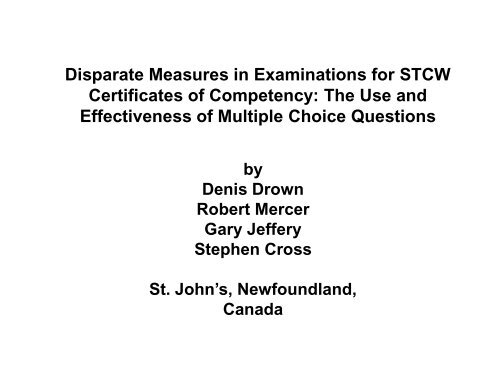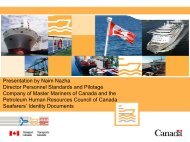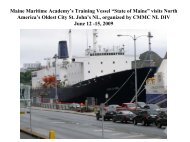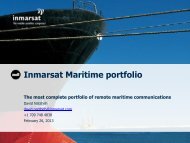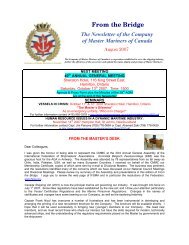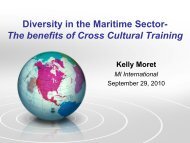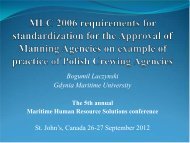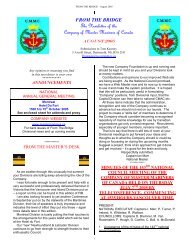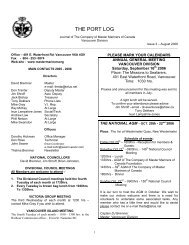ONE, ALL OR NONE OF THE ABOVE Multiple-choice question ...
ONE, ALL OR NONE OF THE ABOVE Multiple-choice question ...
ONE, ALL OR NONE OF THE ABOVE Multiple-choice question ...
Create successful ePaper yourself
Turn your PDF publications into a flip-book with our unique Google optimized e-Paper software.
Disparate Measures in Examinations for STCW<br />
Certificates of Competency: The Use and<br />
Effectiveness of <strong>Multiple</strong> Choice Questions<br />
by<br />
Denis Drown<br />
Robert Mercer<br />
Gary Jeffery<br />
Stephen Cross<br />
St. John’s, Newfoundland,<br />
Canada
Whereas:<br />
What it’s all about<br />
Because:<br />
Then:<br />
MCQ are widely used in MET and Assessment<br />
Use of MC is increasing<br />
Formal training in MC construction is the exception<br />
Many factors influence MC scores<br />
The more these influences are understood and<br />
mitigated the more effective is MC Assessment<br />
Presentation:-<br />
2
Definitions<br />
Public attitudes<br />
Student attitudes<br />
Student Mariner: a student in a second or third year of<br />
education and training towards a STCW certificate of<br />
competency as a Navigating or Engineer Officer.<br />
Student Novice: a student of comparable age and level of<br />
education and English language comprehension to the<br />
student mariner, but with no marine training or experience,<br />
studying a subject other than maritime technology.<br />
4
MCQ Events<br />
1978: Course revisions following STCW „78<br />
1996: Employment screening<br />
2000: Experiment with office staff (10 persons)<br />
2002: Experiment with „focus group‟ (6 persons)<br />
2005: First trial study (35 Middle &19 High School)<br />
2006: Survey & Study (53 countries) (Marseille)<br />
2007: Second trial study (157 test subjects)(Rotterdam)<br />
2009: Full-scale study (930 test subjects)(Szczecin)<br />
5
insufficient data<br />
50%<br />
NOVICES - DECK QUESTIONS<br />
T<br />
e<br />
s<br />
t<br />
45%<br />
40%<br />
S<br />
c<br />
o<br />
r<br />
e<br />
s<br />
(<br />
a<br />
v<br />
)<br />
35%<br />
30%<br />
25%<br />
20%<br />
15%<br />
10%<br />
Males Females 25 1st 2nd V Good Good Not Good Primary Secondary P Sec Today<br />
Gender Age English Comprehension First MC Experience<br />
6
BANANAS<br />
How are cultivated bananas propagated<br />
A. By tissue culture<br />
B. By plant offshoots<br />
C. By transplanting underground stem roots<br />
D. By seeds<br />
Give one reason for your answer<br />
Cultivated bananas are parthenocarpic which<br />
makes them sterile and unable to produce viable<br />
seeds.<br />
7
Ongoing Research<br />
Knowledge<br />
Deduction<br />
Word/Grammar Clue<br />
Word/Concept Association<br />
Guessing<br />
Intuition<br />
8
Question<br />
Structure<br />
Instructor Training in Item<br />
construction<br />
Guessing &<br />
Chance<br />
Testwiseness (cracking the code)<br />
MC Test Experience<br />
Intuition<br />
SUMMARY <strong>OF</strong> MCQ INFLUENCES<br />
Language Skills<br />
Lefthandedness<br />
Cheating<br />
Gender & Age<br />
Examiner preferences<br />
Specimen examinations<br />
General strategies<br />
Changing responses<br />
Student Learning Styles/Skills<br />
Other<br />
Computer<br />
familiarity<br />
Probabilities & Mind Games<br />
impulsivi<br />
9
Qu. Sketch a half section double<br />
bottom A and describe the main<br />
construction features.<br />
Figure 2<br />
8. In Figure 2, of a half section double bottom, A is<br />
indicating a:<br />
A. Bracket, used to increase strength<br />
B. Margin plate, used to increase strength<br />
C. Lightening hole, used to reduce weight<br />
D. Limber hole, used to reduce weight<br />
10
“Upon what meat doth this, our MC, feed, That it is grown<br />
so great”<br />
Cheap<br />
Easy<br />
Quick<br />
Simple<br />
Objective<br />
11
Conclusion & Solution<br />
• MCQ have a place in checking factual knowledge and are<br />
effective assessment tools where there is dialogue between<br />
instructor and student.<br />
• MCQ in STCW competency examinations should be variants<br />
and a minor element in a multi-dimensional examination<br />
process, with effectiveness evaluated during an interview.<br />
• “Disparity” fosters doubt and doubt compromises confidence.<br />
The first step to a solution is to gather detailed and<br />
investigative data about maritime examination methods. Such<br />
a study requires an international and institutional approach.<br />
12
Final Thoughts<br />
29 Jul 2008, The Times: Dyslexic (medical) student to fight multiple<br />
<strong>choice</strong> <strong>question</strong>s in Court.<br />
21 Jan 2010, Washington Post: Medical Student’s (Court) Appeal<br />
Highlights Challenges of Dyslexia.<br />
23 Feb 2010: Sydney Coroners Court findings following a fatal<br />
collision in Sydney Australia Harbour on 29 Mar 2007<br />
13
“The school don‟t teach me proper”<br />
My client was not properly found<br />
competent by the training provider/<br />
authority responsible for issuing the<br />
certificate, because the examination by<br />
which he was assessed was not properly<br />
constructed, neither has it been shown to<br />
be valid or reliable.<br />
14
Disparate Measures in Examinations for STCW<br />
Certificates of Competency: The Use and<br />
Effectiveness of <strong>Multiple</strong> Choice Questions<br />
by<br />
Denis Drown<br />
Robert Mercer<br />
Gary Jeffery<br />
Stephen Cross<br />
<strong>THE</strong> END
End<br />
16
Definitions<br />
Public attitudes<br />
Student attitudes<br />
Student Mariner: a student in a second or third year of<br />
education and training towards a STCW certificate of<br />
competency as a Navigating or Engineer Officer.<br />
Student Novice: a student of comparable age and level of<br />
education and English language comprehension to the<br />
student mariner, but with no marine training or experience,<br />
studying a subject other than maritime technology.<br />
17
What does the term 'head' mean when applied to a fire pump<br />
A. Length of the discharge pipe<br />
B. Height of the discharge pipe<br />
C. Difference between the discharge and suction pressures<br />
D. Sum of discharge and suction pressures<br />
Answer C. I‟m thinking that because options C and D are both<br />
dealing with pressure and there‟s a subtle difference between the<br />
two that one of them is probably correct. Again, I think that<br />
because discharge and suction may be working against each other<br />
that C could be the correct answer. It sounds unlikely that you<br />
could combine discharge and suction. But if not C, then I think D is<br />
the correct one. But probably C again because it‟s longer than the<br />
others – this is a dead giveaway.<br />
18
MCQ Use – Summary<br />
Maritime Administrations<br />
A-II/1 16 A-II/2 19 A-III/1 15 A-III/2 16<br />
Bangladesh 16 USA 19 USA 14 USA 15<br />
Japan 15 Bangladesh 18 Japan 12 Bangladesh 12<br />
USA 14 Japan 18 Bangladesh 10 Chile 9<br />
Australia 11 Australia 14 Canada 8 Japan 9<br />
Canada 9 Canada 11 Chile 8<br />
METS Acting for Maritime Administrations<br />
Philippines 16 China PR 19 China PR 15 China PR 16<br />
China PR 15 Korea Rep 19 Korea Rep 15 Korea Rep 16<br />
Korea Rep 15 Philippines 19 Philippines 15 Philippines 14<br />
Hong Kong 9 Hong Kong 10<br />
Netherlands 8<br />
19
DECK QUESTIONS - Frequency of Correct Responses ≥50%<br />
Test #<br />
Study Test Question #<br />
Basic Questions<br />
Advanced Questions<br />
1 2 3 4 5 6 7 8 9 10 11 12 13 14 15 16 17 18 19 20<br />
Percentage ≥ 50% Correct in Each Test<br />
Novices<br />
Mariners<br />
92 85 62 62 54 85 69 69 54 69 77<br />
4D 11 10<br />
87 77 87 84 90 97 77 61 71 52<br />
Novices: University, English Language & Literature: English Second Language.<br />
Student Mariners: Second Year Navigation: English Second Language.<br />
Question 10: Drinking salt water will<br />
A. dehydrate you<br />
B. prevent seasickness<br />
C. be safe if mixed with fresh water<br />
D. protect against heat cramps<br />
Question 20: Which is an indication of reserve buoyancy<br />
A. Metacentric height<br />
B. Righting moment<br />
C. Freeboard<br />
D. Rolling period<br />
20
MCQ Events<br />
1978: Course revisions following STCW „78<br />
1996: Employment screening<br />
2000: Experiment with office staff (10 persons)<br />
2002: Experiment with „focus group‟ (6 persons)<br />
2005: First trial study (35 Middle &19 High School)<br />
2006: Survey & Study on international use (Marseille)<br />
2007: Second trial study (157 test subjects)(Rotterdam)<br />
2009: Full-scale study (930 test subjects)(Szczecin)<br />
23
Question 10: Drinking salt water will<br />
A. dehydrate you<br />
B. prevent seasickness<br />
C. be safe if mixed with fresh water<br />
D. protect against heat cramps<br />
Question 20: Which is an indication of reserve buoyancy<br />
A. Metacentric height<br />
B. Righting moment<br />
C. Freeboard<br />
D. Rolling period<br />
24
“MCQ are not used in professional marine<br />
examinations administered by or on behalf of the<br />
(UK) Maritime & Coastguard Agency, and<br />
presently there is no intention of introducing such<br />
a system. There is interest in other countries'<br />
applications of MCQ with respect to the<br />
robustness of the technique and the validity of its<br />
results.”<br />
(Permission) 7 July 2006<br />
25
Conclusion & Solution<br />
• MCQ have a place in checking factual knowledge and are<br />
effective assessment tools where there is dialogue between<br />
instructor and student.<br />
• MCQ in STCW competency examinations should be variants<br />
and a minor element in a multi-dimensional examination<br />
process, with effectiveness evaluated during an interview.<br />
• “Disparity” fosters doubt and doubt compromises confidence.<br />
The first step to a solution is to gather detailed and<br />
investigative data about maritime examination methods. Such<br />
a study requires an international and institutional approach.<br />
26
The Debate Continues<br />
You may be right – eventually. Times (Leader) 13 Jun 2006.<br />
Narrow testing It’s the American way. E. Jackson, TES,16 Jun 2006.<br />
<strong>Multiple</strong> <strong>choice</strong> is not a dumb option. M. Cresswell, TES, 23 Jun 2006.<br />
Girls much keener than boys to go to University. A. Frean, Times, 28 Aug 2007<br />
GCSE science <strong>question</strong>s require no scientific knowledge. N, Woolcock,<br />
Times, 6 Jul 2009.<br />
Schools are producing a generation of illiterate scientists. E. McCracken,<br />
Herald Scotland, 28 Mar 2010<br />
Exams for boys, exams for girls. W. Stewart, TES, 8 Jun 2010.<br />
Dyslexic student to fight multiple <strong>choice</strong> <strong>question</strong>s in court. J. Sugden, Times, 29<br />
Jul 2008.<br />
Medical Student’s Appeal Highlights Challenges of Dyslexia. Washington<br />
Post, 21 Jan 2010.<br />
27
A shipboard Oil Pollution Emergency Plan is required of<br />
A. all vessels, regardless of size and commercial application<br />
B. any barge or ship constructed or operated in such a manner<br />
that no oil in any form can be carried aboard<br />
C. an oil tanker of 150 gross tons and above, or other ship of<br />
400 gross tons and above<br />
D. an oil tanker of 400 gross tons and above, or other ships of<br />
150 gross tons and above<br />
B sounds garbled and doesn‟t really make sense. A doesn‟t make<br />
sense as it would be ridiculous if this applied to canoes etc. So it<br />
must be C or D. I‟m thinking C is the correct answer as this would<br />
be essential for even smaller oil tankers – they can still create an<br />
environmental hazard.<br />
28
Tips for Taking <strong>Multiple</strong> Choice Tests<br />
by Dr. Robert Runte<br />
Faculty of Education, University of Lethbridge<br />
“ even though students do not know any of the course<br />
content, or have any grasp of the meaning of the<br />
<strong>question</strong>, they can still score 100% on this quiz if they<br />
are test-wise.”<br />
3. Bogh qo‟ rar zorkrans inkle<br />
A. gi hien<br />
B. gis inkle<br />
C. gish frankel<br />
D. gishen fronks<br />
29
7. Small dry cargo vessels are frequently framed to give<br />
longitudinal strength in in the the deck and double bottom as<br />
well as well as as transverse strength strength in the in ship‟s the ship‟s side. side. This<br />
This<br />
system of framing is known as a ________________<br />
system of framing.<br />
A. Combination<br />
B. Longitudinal<br />
C. Oblique<br />
D. Transverse<br />
30
Which lights are shown by a NUC<br />
vessel, making way<br />
Draw the lights of a NUC vessel,<br />
starboard side, making way.<br />
A<br />
B<br />
C<br />
D<br />
31
Education<br />
Level<br />
Age<br />
Number<br />
of<br />
Participants<br />
Mean<br />
Score:<br />
Range<br />
0-7<br />
Middle<br />
School<br />
High<br />
School<br />
Career<br />
Academy<br />
11-15 35 1.0<br />
17-18 19 2.5<br />
18-24 81 3.1<br />
University 18-24 76 4.0<br />
32
A B C<br />
STCW<br />
Mandatory minimum requirements for certification<br />
A-II/1: I/C NAVIGATIONAL WATCH SHIPS ≥ 500 GT<br />
Competence<br />
Plan and conduct a passage and determine position<br />
Maintain a safe navigational watch<br />
Use radar and ARPA to maintain safety of navigation<br />
Respond to emergencies<br />
Respond to a distress signal at sea<br />
Standard Marine Navigational Vocabulary (IMO)<br />
Visual signalling<br />
Manoeuvre the ship<br />
Monitor cargo operations<br />
Inspect and report defects/damage<br />
Compliance with pollution prevention regulation<br />
Maintain seaworthiness of the ship<br />
Prevent, control and fight fires on board<br />
Operating life-saving appliances<br />
Written Examination<br />
Scoring/Grading<br />
Method<br />
Essay Calc. MCQ<br />
Other<br />
Method<br />
Apply medical first aid on board ship<br />
Monitor compliance with legislative requirements<br />
34
Essay<br />
Calc<br />
MCQ<br />
Other<br />
Essay<br />
Calc<br />
MCQ<br />
Other<br />
STCW 95<br />
Competencies 1<br />
A-II/1<br />
A-II/2<br />
16 19<br />
Exam Method 2<br />
Australia 8 3 0 11 14 12 4 14 16<br />
Bangladesh 16 4 16 16 19 9 18 19<br />
Canada 5 3 9 15 9 3 11 19<br />
Malaysia 12 2 0 13 17 4 0 18<br />
Netherlands 3 1 8 13 2 4 5 11<br />
Philippines 3 0 16 12 5 3 19 12<br />
Sri Lanka 14 3 4 15 17 5 2 13<br />
United Kingdom 10 2 0 16 17 7 0 19<br />
USA 0 5 14 14 0 6 19 18<br />
Means 4 8 2 5 13 10 4 5 14<br />
Survey Results - Maritime Administrations<br />
35
MCQ Use – METS Acting for Maritime Administrations<br />
A-II/1 16<br />
Philippines 16<br />
China PR 15<br />
Korea Rep 15<br />
Hong Kong 9<br />
Netherlands 8<br />
Netherlands 6<br />
Ukraine 5<br />
Sri Lanka 4<br />
Vanuatu 4<br />
Denmark 2<br />
Sweden 1<br />
Iceland 0<br />
Japan 0<br />
Malaysia 0<br />
Sweden 0<br />
Trinidad 0<br />
UK 0<br />
Vietnam 0<br />
A-II/2 19<br />
China PR 19<br />
Korea Rep 19<br />
Philippines 19<br />
Ukraine 6<br />
Netherlands 5<br />
Netherlands 4<br />
Sri Lanka 2<br />
Hong Kong 1<br />
Denmark 0<br />
Iceland 0<br />
Japan 0<br />
Malaysia 0<br />
Sweden 0<br />
Sweden 0<br />
Trinidad 0<br />
UK 0<br />
Vanuatu 0<br />
Vietnam 0<br />
A-III/1 15<br />
China PR 15<br />
Korea Rep 15<br />
Philippines 15<br />
Hong Kong 10<br />
Netherlands 5<br />
Netherlands 5<br />
Sri Lanka 4<br />
Malaysia 2<br />
Denmark 1<br />
UK 1<br />
Iceland 0<br />
Japan 0<br />
Sweden 0<br />
Sweden 0<br />
Trinidad 0<br />
Ukraine 0<br />
Vietnam 0<br />
A-III/2 16<br />
China PR 16<br />
Korea Rep 16<br />
Philippines 14<br />
Ukraine 5<br />
Japan 4<br />
Netherlands 4<br />
Netherlands 3<br />
Sri Lanka 1<br />
UK 1<br />
Denmark 0<br />
Hong Kong 0<br />
Malaysia 0<br />
Sweden 0<br />
Sweden 0<br />
Trinidad 0<br />
Vanuatu 0<br />
Vietnam 0<br />
36
Essay<br />
Calc<br />
MCQ<br />
Other<br />
Essay<br />
Calc<br />
MCQ<br />
Other<br />
STCW 95<br />
Competencies 1<br />
A-III/1<br />
A-III/2<br />
15 16<br />
Exam Method 2<br />
China PR 0 0 15 0 0 0 16 0<br />
Denmark 6 3 1 12 9 5 0 13<br />
Germany<br />
Hong Kong China 0 0 10 13 14 2 0 10<br />
Japan 15 0 0 15 15 0 4 16<br />
Korea Republic 0 0 15 13 0 0 16 11<br />
Sweden 1 0 0 15 3 2 0 16<br />
Trinidad and Tobago 3 0 0 15 5 1 0 16<br />
Ukraine 15 0 0 11 12 2 5 11<br />
United Kingdom 6 2 1 10 10 4 1 6<br />
Vietnam 10 0 0 9 14 0 0 6<br />
Means 4 3 0 2 7 5 1 2 6<br />
Survey Results - METS<br />
37
STUDY ITEM<br />
1. Development<br />
What are the procedures for planning, designing and preparing tests<br />
How much time is allocated to development<br />
2. Determination of cognitive levels<br />
How are learning styles, personal strengths and weaknesses recognised<br />
Are formal ability and aptitude tests used to determine cognitive level<br />
11. Training of MCQ constructors<br />
What are the procedures for training test constructors<br />
What time is allowed for test writing, standardizing and validating<br />
12. Popularity of MCQ<br />
What are the advantages and disadvantages of MCQ tests<br />
13. Other items of interest<br />
14. Experiences<br />
Study Extract<br />
38
Intuition<br />
Sarnacki defines intuition as “a subject‟s capacity to utilize<br />
the characteristics and formats of the test and/or the testtaking<br />
situation to receive a high score”, with a definitional<br />
addendum that “testwiseness is logically independent of the<br />
examinee‟s knowledge of the subject matter for which the<br />
items supposedly measure”.<br />
39
The Study<br />
• Background: The IMLA 14 study and survey, and the IMEC 19 exploratory<br />
study, both described in the Paper.<br />
• Supposition: If persons (novices) are given a MCQ test on a subject with<br />
which they are unfamiliar then scores must reflect factors other than subject<br />
knowledge.<br />
• Instrument: 20-<strong>question</strong> marine technology tests drawn randomly from a<br />
1500 MCQ pool contributed by METS and maritime administrations.<br />
• Method: 44 individual tests completed by 930 mariner and novice study test<br />
subjects from N America, Europe, Asia and the Subcontinent. Mariner and<br />
novice scores are compared.<br />
• Objective:To provide insights into the relative significance of gender, age,<br />
English comprehension and previous test experience so that these factors<br />
may be considered when constructing MCQ items.<br />
40
Mean of 20 Questions<br />
12.0<br />
Mariner & Novices - Deck Questions<br />
10.0<br />
8.0<br />
6.0<br />
4.0<br />
2.0<br />
Mariners<br />
Novices<br />
0.0<br />
1 2 3 4 5 6 7 8 9 10 11 12 13<br />
Table 1D: Test 1 - 13: Questions 1 - 20 (Basic & Advanced)<br />
41
.<br />
Conclusions<br />
• MCQ tests are useful in-course assessment tools.<br />
• Factual-based MCQ are ineffective as part of an examination process leading<br />
to a STCW certificate of competence, because MCQ cannot reliably assess<br />
subject knowledge, and are not designed to evaluate competence.<br />
• MCQ should be constructed clearly and explicitly with attention to the<br />
principles of Maritime English.<br />
• If MCQ are used in STCW competency examinations they should be variants<br />
and a minor element in a multi-dimensional process. Variants require<br />
resources for construction, validation, and marking. Considering the possible<br />
consequences of incompetence, these resources are a good investment in<br />
a safe maritime transportation industry.<br />
42
insufficient data<br />
T<br />
e<br />
s<br />
t<br />
50%<br />
45%<br />
40%<br />
NOVICES - DECK QUESTIONS<br />
S<br />
c<br />
o<br />
r<br />
e<br />
s<br />
(<br />
a<br />
v<br />
)<br />
35%<br />
30%<br />
25%<br />
20%<br />
15%<br />
10%<br />
Males Females 25 1st 2nd V Good Good Not Good Primary Secondary P Sec Today<br />
Gender Age English Comprehension First MC<br />
1 – 10<br />
11 – 20<br />
All<br />
43
MCQ Use – Summary<br />
Maritime Administrations<br />
A-II/1 16 A-II/2 19 A-III/1 15 A-III/2 16<br />
Bangladesh 16 USA 19 USA 14 USA 15<br />
Japan 15 Bangladesh 18 Japan 12 Bangladesh 12<br />
USA 14 Japan 18 Bangladesh 10 Chile 9<br />
Australia 11 Australia 14 Canada 8 Japan 9<br />
Canada 9 Canada 11 Chile 8<br />
METS Acting for Maritime Administrations<br />
Philippines 16 China PR 19 China PR 15 China PR 16<br />
China PR 15 Korea Rep 19 Korea Rep 15 Korea Rep 16<br />
Korea Rep 15 Philippines 19 Philippines 15 Philippines 14<br />
Hong Kong 9 Hong Kong 10<br />
Netherlands 8<br />
Individuals with Maritime Interests<br />
Philippines 16 Greece 19 Philippines 14 Philippines 14<br />
Greece 15 Philippines 19 Greece 11<br />
Poland 15 Poland 18<br />
Singapore 9<br />
44
BANANAS<br />
How are cultivated bananas propagated<br />
A. By tissue culture<br />
B. By plant offshoots<br />
C. By transplanting underground stem roots<br />
D. By seeds<br />
1500 Study Test MCQ - Response Count<br />
A B C D<br />
26% 25% 22% 27% 100%<br />
Give one reason for your answer<br />
Cultivated bananas are parthenocarpic which<br />
makes them sterile and unable to produce viable<br />
seeds.<br />
45


